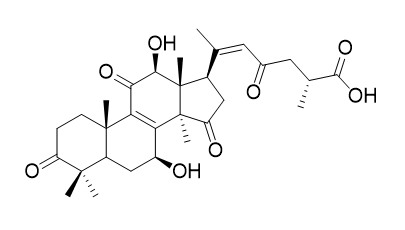Providing storage is as stated on the product vial and the vial is kept tightly sealed, the product can be stored for up to
24 months(2-8C).
Wherever possible, you should prepare and use solutions on the same day. However, if you need to make up stock solutions in advance, we recommend that you store the solution as aliquots in tightly sealed vials at -20C. Generally, these will be useable for up to two weeks. Before use, and prior to opening the vial we recommend that you allow your product to equilibrate to room temperature for at least 1 hour.
Need more advice on solubility, usage and handling? Please email to: service@chemfaces.com
The packaging of the product may have turned upside down during transportation, resulting in the natural compounds adhering to the neck or cap of the vial. take the vial out of its packaging and gently shake to let the compounds fall to the bottom of the vial. for liquid products, centrifuge at 200-500 RPM to gather the liquid at the bottom of the vial. try to avoid loss or contamination during handling.
Journal of ethnopharmacology, 2017, 210:287.
Network pharmacology analysis of the anti-cancer pharmacological mechanisms of Ganoderma lucidum extract with experimental support using Hepa1-6-bearing C57 BL/6 mice.[Reference:
WebLink]
Ganoderma lucidum (GL) is an oriental medical fungus, which was used to prevent and treat many diseases. Previously, the effective components of Ganoderma lucidum extract (GLE) were extracted from two kinds of GL, Ganoderma lucidum (Leyss. Ex Fr.) Karst. and Ganoderma sinense Zhao, Xu et Zhang, which have been used for adjuvant anti-cancer clinical therapy for more than 20 years. However, its concrete active components and its regulation mechanisms on tumor are unclear. In this study, we aimed to identify the main active compounds from GLE and to investigate its anti-cancer mechanisms via drug-target biological network construction and prediction.
METHODS AND RESULTS:
The main active compounds of GLE were identified by HPLC, EI-MS and NMR, and the compounds related targets were predicted using docking program. To investigate the functions of GL holistically, the whole active components of GL and related targets were predicted based on four public databases. Subsequently, the compound-target network and component-target network were constructed respectively, and they were overlapped to detect the kernel potential targets in both networks. Furthermore, the qRT-PCR was used to validate the expression levels of target genes in GLE treated Hepa1-6-bearing C57 BL/6 mice. In our work, 12 active compounds of GLE were identified, including Ganoderic acid A, Ganoderenic acid A, Ganoderic acid B, Ganoderic acid H, Ganoderic acid C2, ganoderenic acid D, Ganoderic acid D, Ganoderenic acid G, Ganoderic acid Y, Kaemferol, Genistein and Ergosterol. Using the docking program, 20 targets were mapped to 12 compounds of GLE. Furthermore, 122 effective active components of GL and 116 targets were holistically predicted using public databases. Compare with the compound-target network and component-target network, 6 kernel targets were screened, including AR, CHRM2, ESR1, NR3C1, NR3C2 and PGR, which was considered as potential markers and might play important roles in the process of GLE treatment. GLE effectively inhibited tumor growth in Hepa1-6-bearing C57 BL/6 mice. Moreover, qRT-PCR data demonstrated the expression levels of NR3C1, NR3C2 and AR are up-regulated and PGR, ESR1 and CHRM2 are down-regulated.
CONCLUSIONS:
The results indicated that these 6 kernel target genes might act as potential markers to evaluate the curative effect of GLE treatment in tumor. The combined data provide preliminary study of the pharmacological mechanisms of GLE. GLE may be a promising potential therapeutic and chemopreventative candidate for anti-cancer.



